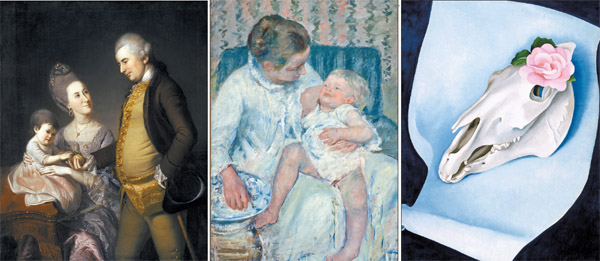Renowned art tells uniquely American tale

Charles Willson Peale’s “Portrait of John and Elizabeth Lloyd Cadwalader and Their Daughter Anne” (1772) is on loan from the Philadelphia Museum of Art.;Mary Cassatt’s “Mother About to Wash Her Sleepy Child” (1880) is on loan from the Los Angeles County Museum of Art ;Georgia O’Keeffe’s “Horse’s Skull with Pink Rose” (1931) is on loan from the Los Angeles County Museum of Art.
The show, titled “Art Across America,” is an effective summary of the country’s 300-year art history. In this exhibition featuring 168 paintings and crafts, viewers can see at least one piece of art from the most important names in American art.
They range from John Singleton Copley, one of the few 18th-century colonial American artists who gained fame in England, to Jackson Pollock, an abstract expressionist of the 20th century.
“Though many Koreans are aware of the pop artist Andy Warhol, whose work is also on display, and other post-1960s American artists, that’s not true for artists of earlier periods, including Winslow Homer and Thomas Eakins,” said Kim Seung-ik, a curator of the Korean museum. “Works by these artists will illuminate dynamic connections between how American art and the nation’s identity developed in the flow of its history.”
The exhibition is divided into six sections. The first part, “American People,” includes a portrait of the first U.S. president, George Washington, by Rembrandt Peale. There is also a piece by his father, Charles Willson Peale, who named his sons after European masters including Rembrandt.
The Peales were an important artist family in colonial America. The father Peale’s painting “Portrait of John and Elizabeth Lloyd Cadwalader and Their Daughter Anne” is displayed with luxurious furniture and crafts of the 18th century.
The second, “American Landscape - East to West,” features landscape paintings by the artists of the Hudson River School. They were a group of painters who depicted the landscapes of the Hudson River Valley in spectacular romantic paintings.
The section also includes landscape paintings by these artists’ successors, including the spectacular painting of the Grand Canyon by Thomas Moran. They show the American landscapes came to include those of the West with the development of that region.
A third section, “Daily Life in Art,” follows American daily life around the time of the Civil War. It includes paintings by Eakins and Homer, who depicted the simple and healthy lives of frontiersmen. Among the exhibits are also American trompe l’oeil still-life paintings of optical illusion by William Harnett and John Peto.
The fourth section, “Cosmopolitan America,” features American impressionists, many of whom studied in France and other European regions and also gained popularity in Europe. The exhibits here include the famous female artist Mary Cassatt’s “Mother About to Wash Her Sleepy Child” and the renowned portrait artist John Singer Sargent’s “A Parisian Beggar Girl.”
The paintings by William Merritt Chase depicting a woman in kimono in this section show that Japonism, or the vogue of Japanese art and crafts in Europe, also influenced American artists. A painting by James Abbott McNeill Whistler is also included in the section.
The “Modern America” section features paintings depicting urbanization and industrialization of America such as one by Charles Demuth and also includes three fine paintings by the female artist Georgia O’Keeffe, including one depicting Calla Lilies and one depicting a horse skull in her signature style of half abstraction.
“American Art After 1945” shows American work as the center of the art world, including paintings by abstract expressionists such as Pollock and Mark Rothko.
The exhibits are on loan from the Los Angeles County Museum of Art, the Philadelphia Museum of Art, the Museum of Fine Arts, Houston and the Terra Foundation for American Art.
“You will see American art is trying to be more direct and immediate than European art, which uses layers of references,” said Michael Govan, CEO and director of the Los Angeles County Museum of Art, who is visiting Seoul. “It must be related with the Americans’ directness to the new world, new frontier.”
The exhibition runs through May 19 and admission is 12,000 won ($11.04) for adults.
The museum opens at 9 a.m. It closes at 6 p.m. on Tuesday, Thursday and Friday; at 7 p.m. on Sunday; and 9 p.m. on Wednesday and Saturday. It is closed on Monday. Go to Ichon station, line No. 4, exit 2.
For more information, visit www.artacrossamerica2013.com or call (02) 1661-2440.
By Moon So-young [symoon@joongang.co.kr]










with the Korea JoongAng Daily
To write comments, please log in to one of the accounts.
Standards Board Policy (0/250자)